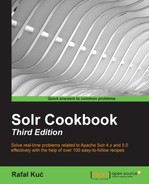Welcome to Solr Cookbook, Third Edition. You will be taken on a tour of the most common problems that a user might face while dealing with Apache Solr. You will also explore some of the features that were recently introduced in Solr. You will learn how to deal with the problems when configuring and setting up Solr, handle common queries, fine-tune Solr instances, set up and use SolrCloud, use faceting and grouping, fighting common problems, and many more things. Each and every recipe is based on real-life problems and provides solutions along with detailed descriptions of the configuration and code that was used.
Chapter 1, Apache Solr Configuration, covers Solr configuration recipes, along with setting up ZooKeeper, migrating from master to slave, and configuring Solr for different use cases.
Chapter 2, Indexing Your Data, as the name suggests, explains data indexing, such as binary files indexing, using Data Import Handler, language detection, updating a single field of document, and much more.
Chapter 3, Analyzing Your Text Data, concentrates on common problems when analyzing your data, such as stemming, geographical location indexing, or using synonyms.
Chapter 4, Querying Solr, describes querying Apache Solr, such as nesting queries, affecting the scoring of documents, phrase searching, or using the parent-child relationship.
Chapter 5, Faceting, is dedicated to the faceting mechanism in which you can find the information needed to overcome some problems that you might encounter while working with Solr and faceting.
Chapter 6, Improving Solr Performance, focuses on improving your Apache Solr cluster performance with information such as cache configuration, indexing speed up, and much more.
Chapter 7, In the Cloud, covers the cloud side of Solr—SolrCloud, setting up collections, replicas configuration, distributed indexing and searching, as well as aliasing and shard manipulation.
Chapter 8, Using Additional Functionalities, explains how we can highlight long text fields, sort results on the basis of function value, check user spelling mistakes, and use the grouping functionality.
Chapter 9, Dealing with Problems, is a small chapter dedicated to the most common situations such as memory problems, tuning segment merges, and others.
Chapter 10, Real-life Situations, describes how to handle real-life situations such as implementing different autocomplete functionalities, using near real-time search, or improving query relevance.
